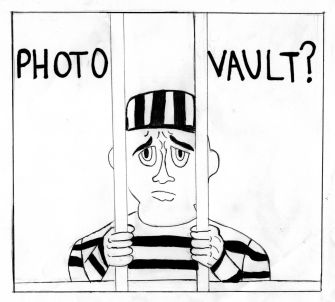Hundreds of naked photos were exchanged between high school students at Cañon City High School in Colorado, prompting a felony investigation by police on Nov. 6. These photos were covertly stored and shared on phone applications known as “photo vaults,” disguised, in some cases, as calculator apps.
By providing a distribution platform for what is child pornography under the law, photo vault companies are culpable as ‘enablers.’ Photo vault app developers should share in the punishment, via fines or other means, for the life altering outcomes to teens who used their apps and are charged or convicted of “sex crimes.”

While distributing child pornography may not be the app’s intended purpose, under many existing child pornography laws including the law in California, this activity alone may be a crime.
In using these applications, the accused Cañon City students face potentially serious criminal charges, which may require that they register as sex offenders. Once a “sex offender,” the label remains for life, and can limit one’s ability to find housing and employment.
Although Redwood students would probably find this punishment wildly disproportionate, the same thing could happen here under current California law, in accordance with [Penal Code 311.2(b)].
The issue is not just theoretical. Recent statistics show that ‘sexting’ is very common among high school students. According to a 2014 Drexel University study, 54 percent of university students surveyed said they ‘sexted’ as minors.
Very few of these students are aware that, aside from being edgy, it may also have severe consequences under the law. The same study found that 61 percent of sexters were unaware that sending ‘sexts’ could be considered child pornography, a felony charge.
No one, it seems, has questioned whether the hundreds of photo vault app makers will share the legal responsibility for teen sexting. There is no doubt that photo vault apps provide a covert distribution platform for nude photos of minors.
The app developers have escaped scrutiny so far.
“Calculator Lock,” one photo vault application, transforms from a calculator into a secret vault where users can store photos, messages or browse the internet. Another app, Photo Vault, uses decoy passwords to stump “snoopers.” Once inside, users can send private messages and store illicit photos.
There are completely legal uses of these apps, depending on the nature of the photos and the age of the user. However, for minors, these applications provide a forum for unlawful activities. They share similarities with “darknet” websites such as Silk Road, which once provided a platform for a variety of illegal transactions. Although photo vault applications may appear harmless, they subject unwitting users to criminal charges in many states including California.
These platforms provide a false sense of security and anonymity for teen sexters. No matter how strong and well crafted, privacy policies cannot be used to conceal criminal activity.
In the Colorado Cañon City High School case, students face Class 3 felony charges, which, if upheld, cannot be expunged from their record. An 18-year-old teen sexter, an ‘adult’ by law, could also be charged as a child pornographer and subsequently, a sex offender. The punishment does not fit the crime.
With such serious legal repercussions, educators and photo vault purveyors are obligated to inform teens on the law. The photo vault companies should, by regulation, be required to carry a prominent warning informing of potential criminal penalties for teen sexters. If it turns out that the predominant use of photo vault applications is for illegal activities, perhaps more restriction is in order.
The risks of too much online ‘exposure’ are clear. App makers should be held accountable for the illegal activities they facilitate, before another impulsive gesture turns criminal.






